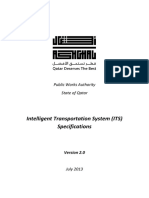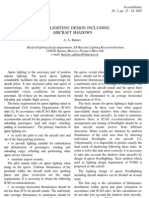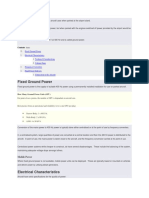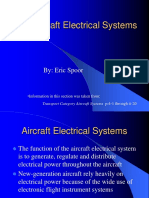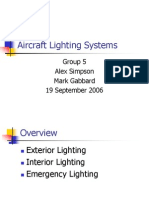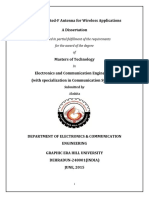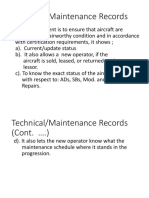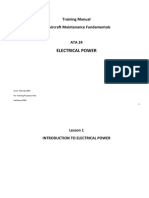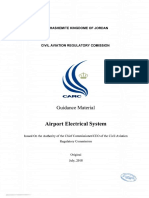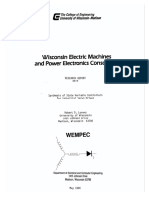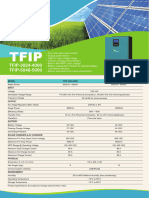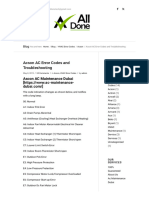Advanced Power Converters For More Electric Aircraft Applications
Advanced Power Converters For More Electric Aircraft Applications
Uploaded by
joonimCopyright:
Available Formats
Advanced Power Converters For More Electric Aircraft Applications
Advanced Power Converters For More Electric Aircraft Applications
Uploaded by
joonimOriginal Description:
Original Title
Copyright
Available Formats
Share this document
Did you find this document useful?
Is this content inappropriate?
Copyright:
Available Formats
Advanced Power Converters For More Electric Aircraft Applications
Advanced Power Converters For More Electric Aircraft Applications
Uploaded by
joonimCopyright:
Available Formats
97039
ADVANCED POWER CONVERTERS FOR MORE ELECTRIC AIRCRAFT APPLICATIONS'
W. G. Homeyer, E .E. Bowles, and S. P. Lupan
General Atomics
P.O. Box 85608
San Diego, California 92186-9784
Phone: (916) 455-2198, FAX: (619) 455-4341
P. S. Walia
Northrop Grumman Corporation, Military Aircraft Systems Division
One Hornet Way 9B36l62
El Segundo, California 92050-3277
Phone: (310) 332-6956, FAX: (310) 332-1987
M. A. Maldonado
Wright Laboratory, WUPOOX
1950 Fifth Street, Building 18
Wright-Patterson AFB, OH 45433-7251
Phone: (937) 255-9392, FAX: (937) 656-4781
at a frequency of 120 kHz. In the dc-dc converter, the transformer
output current is rectified with a full bridge of Schottky diodes.
In the dc-ac inverter, there are four independent secondary
windings per phase whose rectified voltages are summed by
switching Field Effect Transistors (FET) to produce a 400 Hz
sine wave output. A novel switching technique combines pulse
width modulation with the multi-step approach to produce an
output sine wave with less than 2% total harmonic distortion and
minimal filtering requirements.
The paper describes the design of both units and the resulting
performance. The results of tests on both units are summarized.
ABSTRACT
A dc-dc converter and a dc-ac inverter are under development
for More Electric Aircraft (MEA) use. They are both highly
compact and are designed to operate from 270 Vdc input power
and produce output power that meets requirements for fighter
aircraft, including compliance with MIL-STD-704E and MILSTD-461D guidelines. Both units are designed to be cooled with
Poly Alpha Olefin (PAO) at 30C maximum inlet temperature
and to operate for at least 30 s after a loss of coolant flow before
shutting down. Both units are designed to withstand 20 Gs shock
loadings and random vibration loadings up to 0.04 Gm;/Hz for
the dc-dc converter and 0.36 G,:/Hz
for the dc-ac inverter. The
reliability goal is 25,000 hour Mean Time Between Failures
(MTBF). Both units incorporate under/over voltage, short circuit,
and over temperature protection. The dc-ac inverter also has
overhnder frequency, dc content, waveform distortion, and zero
voltage content protection.
The dc-dc converter provides 5.6 kW at 29rt0.5 Vdc with an
efficiency of 90%. It weighs 8.9 lb and is 5" long by 5" wide by
5.5" high (138 in3). The dc-ac inverter provides 8 kVA of three
phase power at (1 15=k1.5)/200Vac and 400 Hz with an efficiency
of 87%. It weighs 18.2 Ibs and is 11.5" long by 5" wide by 5.5"
high (316 in3).The small size and light weight of the units results
from the use of a high frequency series resonant input inverter,
and the use of a small transformer with thin planar copper
windings and a ferrite core to transfer the resonant current energy
through a rectifier to a dc voltage output capacitor. Insulated
Gate Bipolar Transistors (IGBT) in the input inverters, used for
both the dc-dc converter and dc-ac inverter, switch at zero current
INTRODUCTION
The selection of 270 Vdc as the primary power for the MEA
program created a requirement for power converters to provide
the 28 Vdc power used by some equipment and the three phase
power at 1 15/200 Vac and 400 Hz used by other equipment. Both
the dc-dc converter and dc-ac inverter draw their power from the
270 Vdc bus. Northrop Grumman Corporation, the prime
contractor for the Power Management gnd Distribution for More
Electric Aircraft (MADMEL) program developed Product
Function Specifications (PFS) #MDEPS002 (Walia, 1995a) for
the dc-dc converter and #MDEPS003 (Walia, 1995b) for the dcac inverter. Based 011 competitive source selection through the
RFP process, General Atomics was selected to develop both the
dc-dc converter and the dc-ac inverter.
REQUIREMENTS
The objective of the program is to develop advanced high
power density, lightweight dc-dc converter and dc-ac inverter line
replaceable units designed for installation and operation in a
tactical aircraft environment. The baseline requirements for the
dc-dc converter and dc-ac inverter are listed in Tables I and 2.
'This work is sponsored by the Aero Propulsion and Power Directorate,
Wright Laboratory (AFMC), United States Air Force, Wright-Patterson
AFB, Ohio 45433-6533 through a Purchase Order issued by the Northrop
Grumman Corporation to General Atomics
591
TABLE 1. DC-DC CONVERTER REQUIREMENTS
TABLE 2. DC-AC INVERTER REQUIREMENTS
Cooling (PA0 liquid cooling, must be capable of 30 second operation without
cooling before over temperature shutdown)
Weight Goal: 9 Ibs
Volume Goal: 160 in?
Inpnt Voltage
- 270 Vdc per MIL-STD-704E except ripple and transient voltage may exceed
MILSTD-704E limits
output
- Power rating
5.6 kW
- Nominal voltage
28 Vdc
2940.5 Vdc
- Voltage regulation
More stringent than MIL-STD-704E
Transient voltage
Per MIL-STD-704E
Ripple voltage
Per ML-STD-704E
- Distortion factor
- Distortion spectrum Per MIL-STD-704E
- Short-circuit current 200 - 225% rated current for a minimuin of 5 s
EMVEMC
Per MLL-SlD-461D
- Efficiency
90% minimuin
Protection functions
- Over voltage
Per MIL-STD-704E
20 Vdc or less for 3.540.5 s
- Under voltage
Over temperature
Converter internal temperature TBD "F
20 g's, 0.04 G,?/Hz
Shock and vibration
25,000 hour MTBF
Reliability
Cooling (PA0 Liquid cooling; must be capable of 30 second operation whlioot
cooling before over temperature shutdown)
Weight goal: 16 Ibs
Volume goal: 240 111)
Input voltage
- 270 Vdc per MIL-STD-704E except ripple and transient voltage may exceed
MIL-STD-7O4E limits
Output
-
Power rating
- Nommal voltage
- Voltage regulation
- Tiansient
voltage
- Voltage modulation
- Voltage modulation frequency
characteristics
Voltage wavefonn
- DC content
- Steady-state frequency
- Frequency transient
DESIGN
The dc-dc and dc-ac units have common features that
contribute to their high performance and small size and weight.
They have the same high frequency (120 kHz) resonant circuit in
their input inverter sections. The resonant circuit allows the
IGBTs in the inverter bridge to be switched at zero current, which
reduces switching losses and permits operation at 120 kHz. The
high frequency makes the harmonics much easier to filter,
producing high power quality without large filter capacitors.
Planar transformers with ferrite cores are used in the two
units. In the dc-ac units, the leakage inductance of the
transformers is adjusted to match the inductance required by the
resonant circuit, so a.separate inductor is not required. In the dcdc units, split ferrite cores on the leads from the secondary to the
rectifier provide the resonant inductance.
The power components for the dc-dc rectifier circuit and the
dc-ac 400 Hz output circuit are all mounted on alumina ceramic
cards with Direct Bonded Copper (DBC) conductor sheets on
both sides. The transformer windings of the dc-ac unit are also
made from ceramic cards with 0.012-inch-thick DBC conductors
on both sides of a 0.025-inch thick alumina sheet. The conductors
are electrically connected to one anothcr as required and then
thermally bonded to their neighbors by electrically insulating
sheets.
PA0 coolant (0.2 gpm for dc-dc, 0.5 gpm for dc-ac @ 60 psi
and ~ 3 0 C
inlet) is circulated in 118" copper tubes to remove heat
from the transformer and power boards. Heat sinks near the
temperature-sensitive power semiconductors are sized to allow
the units to operate for 30 s after coolant flow is interrupted
before they have to shut down to prevent damage due to
overheating. For the dc-dc rectifier and dc-ac output inverter
cards, the heat sinks are metal matrix composites (Al-Sic). The
copper tubes on the boards are connected to those on other boards
by soldered copper sleeves after the boards are assembled into the
units. The converters are designed to be cooled by water as well
as PA0 for laboratory testing.
- Frequency modulatioii
- Pliase seqnence
-Voltage unbalance and phase
displacement
- Power factor
- Overload
- Short-circuit current
- EMYEMC
-Efficiency
*
Protection functions
- OverloadShort circuit
- Over voltage
- Under voltage
- Over/Under frequency
- DC content
- Waveform distortion
- Zero voltage content
- Over temperature
Shack and vibration
Reliability
kVA
1 I51200 Vac, 1 Phase, 400 Hz
1150+1.5Vac
More stringent than MIL-STD704E
Maximom 2 0 volts peak-to-peak
Per MIL-STD-704E
8
Ciest tactoi I 4115%
Single liannonic <2% of
tundamental
THD <4% and diqtortioii
spectrum per MIL-STD-704E
Maxiinnin 0 6 volt-seconds
above 0 25 V
400*4 Hz
Mole stimgent than ML-STD704E
Per MIL-STD-704E
Pel MIL-STD-704E
Foi 0 l o iated balanLed ]odds
1 O%, 12011 5"
For 116 unbalanced loads I 5%,
12011 5"
For 1/1 unbalanced loads 2 O%,
12012 0"
0 4 lag to 0 95 lead
10 kVA for 5 inin and 12 kVA
f0l 5 s
200% iated cunentiphase for a
ininimuin of 1 s
Per MIL-STD-461 D
85% miniininn
20 g's, 0.36 G,,,:IHz
25,000 Iiour MTBF
Military style conneLtors mounted on the front cover are used
for input and output power and control and diagnostic sigiials
DC-DC CONVERTER
Figure 1 shows the schematic diagram ot the dc-dc converter.
Schottky diodes are used in the rectifier bridge to reduce
rectification losses An exploded view of the dc-dc converter
assembly is shown in Figure 2
DC-AC INVERTER
Figure 3 shows the schematic diagram of the dc-ac inverter
Each phase has its own input inverter and a transformer with four
isolated secondary windings, each of which is connected to a
half-bridge rectifier to create a 40 Vdc power source The four
592
40 Vdc power sources in each phase are connected in series as
needed to construct the 115 Vac, 400 Hz output for that phase by
means of an FET bridge. As shown in Figure 4, the FET bridge
can select a positive or negative 40 Vdc output, or bypass the 40
Vdc source with zero voltage rise. Thus, the four bridges in each
phase allow output voltages of -160, -120, -80, -40, 0, +40, +SO,
+120, or +160 V to be selected. The stepped sine wave that the
four bridges could produce is smoothed by application of Pulse
Width Modulation (PWM) to one or another of the bridges as
shown in Figure 5. This combination, called a Multi-Step Inverter
(MSI) creates a sine wave with <2% total harmonic distortion at
power factors from 0.4 lagging to 0.95 leading, as shown in
Figure 6. A master control card synchronizes the three phases and
sends and receives diagnostic and control information linking the
inverter with the power management and distribution system.
The exploded view of the dc-ac inverter in Figure 7 shows the
stack of cards for each phase in a linear array with dashed lines
showing how the stacks are assembled with each other and into
the enclosure.
shown that vias connecting parallel current paths on opposite
sides of the transformer cards had failed, which doubled the
current density in the secondary winding and thus quadrupled the
ohmic losses. These vias, which were made by powder
compaction by the first DBC card supplier, have been repaired.
Vias in recent DBC cards are made from solid copper pins and
should be more reliable.
The problems met in development have been overcome, as
demonstrated by recent test results. The dc-dc converter has been
assembled and tested at full power. All power specifications were
met in tests at high and low line voltage and 0-100% load.
Typical bridge current and output voltage traces are shown in
Figure 9. The converter has been operated for 2.5 s in the short
circuit condition with 400 A output, as shown in Figure 10.
One phase of the dc-ac inverter has been assembled and
operated at full power of 2.7 kW and shown to have <2% total
harmonic distortion with an output impedance and filter
impedance of < I ohm and an effective PWM frequency of
550 kHz. All power and voltage specifications were met.
FABRICATION AND TESTING
Figure 8 shows the dc-dc converter and dc-ac inverter LRU's
side by side. Several problems were encountered during
fabrication and testing that caused delays. The 4.5 in ceramic
circuit cards were found to be at the limit of DBC fabrication
technology. The first supplier to attempt this was unable to
complete the order, and the second had many rejects before they
were finally successful.
The compact design was found to require extensive isolation
and shielding to protect IGBT and FET gate controls from EMI.
The flush-mounted MILPACK IGBTs with integrated antiparallel
diodes used at first in the input inverter for both dc-dc and dc-ac
units proved to be unsuitable for a development program. They
failed often under test could not be replaced for weeks by the
supplier that had made them and installed them on the circuit
card.
Several planar transformers assembled with ThermagonTM
laminating sheets between winding cards were found to be
shorted after bonding and could not be disassembled. It appears
that the material loses its dielectric strength during curing unless
it has just been outgassed in vacuum. When transformers were
assembled with other insulators, winding losses were found to be
higher than expected. Careful examination of the transformer has
CONCLUSIONS
Advanced dc-dc converters and dc-ac inverters are being
developed for MEA applications. Through application of recent
advances in power semiconductor technology in innovative
circuits, these units provide exceptional power quality and are
much smaller and lighter than previous units in this power range.
The efficiency of the dc-dc converter was measured to be 88%
and is being increased by changes in the transformer and its
secondary connections. The 5.6 kW dc-dc converter weighs about
9 Ib and its volume is 138 in3. The 8 kVA dc-ac inverter weighs
18.2 Ib and its volume is 316 in3. Problems encountered in early
tests have been corrected by component changes. Testing of these
units to verify their performance is in progress. The two dc-dc
units are scheduled to be delivered in June and the dc-ac units in
July and August, 1997.
+270 Vdc
0
REFERENCES
Walia, P.S., 1995a "Product Function Specification for a DCDC Converter for MADMEL Ground Demonstrator Specification
Number MDEPSOOZ"
Walia, P.S., 1995b "Product Functim Specification for a DCAC Inverter for MADMEL Ground Demonstrator Specification
Number MDEPS003"
Resonant
Circuit
+28 Vdc
rcrr
I-
Input filter
Rectifier
IGBT Bridge
Planar
Transformer
FIG. 1 DC-DC CONVERTER SCHEMATIC
593
Fill-,
INPUT INVERTER CARD
*.
IINVERTER CONTROLCARD
*.
TRANSFORMER PRIMARY
SFORMER SECONDARY
RECTIFIER CARD
8 9 Ib WEIGHT
5" LONG X 5" WIDE X 5 5' HIGH
FIG. 2 EXPLODED VIEW OF DC-DC CONVERTER ASSEMBLY
FIG. 3 DC-AC INVERTER SCHEMATIC
(9.
(BYPASS)
!-
t-
I-
!-
Vout = WSITIVE V
SWITCHES 1 AND 4 ON
Vout P 0 VOLTS
SWIKHES 3 ANC 4 ON
(a)
(b)
Vouc il NEGATI'VE V
SWITCHES 2 AND 3 OEl
(5)
FIG. 4 BRIDGE SWITCH POSITIONS TO PROVIDE POSITIVE, NEGATIVt, OR
ZEROVOLTAGEOUTPUT
594
STEPPED SINE WAVE
PWM STEPPED SINE WAVE
FIG. 5 SINE WAVE SYNTHESIS WITH THE MSI
2 1 A rm,
3uH
7"n
J4
FIG. 6 SINE WAVE TO LOAD FROM MSI
INPUT INVERTER CARD
INPUT INVERTER CONTROL CARD
TRANSFORMER PRIMARY
TRANSFORMER SECONDARY
MSI CARD
MSI CONTROL CARD
INPUT/OUTPUT SIGNAL CARD
STRUCTURAL BULKHEAD
FIG. 7 EXPLODED VIEW OF DC-AC INVERTER ASSEMBLY
595
FIG. 8 PHOTOGRAPH OF DC-DC CONVERTER AND DC-AC INVERTER
CHI-
cv-
cH3yoanv
'
BRIDGE
BRIDGE
CURRENT
VOLTAGE
w-m
*$us/div
OUTPUT
VOLTAGE
OUTPUT CURRENT (100 V
PER DIVISION WITH SCALE
ZERO AT BOTTOM)
P
BRIDGE CURRENT (SCALE
ZERO AT CENTER)
FIG. 10 DC-DC CONVERTER SHORT CIRCUIT TEST
DATA (NOTE LOWER TRACE IS TIME EXPANSION
OF PORTION OF UPPER TRACE IN RECTANGULAR
BOX)
FIG. 9 DC-DC CONVERTER DATA AFTER 32 MINUTE
TEST RUN (NOTE LOWER TRACE IS TIME
EXPANSION OF PORTION OF UPPER TRACE IN
RECTANGULAR BOX)
596
You might also like
- Renewable Energy Systems - Simulation With Simulink and SimPowerSystemsDocument464 pagesRenewable Energy Systems - Simulation With Simulink and SimPowerSystemsCasual Gamer100% (4)
- Simulation, Design and Construction of High Voltage DC Power Supply atDocument6 pagesSimulation, Design and Construction of High Voltage DC Power Supply atmenilanjan89nLNo ratings yet
- AC 21-46 v3.0Document7 pagesAC 21-46 v3.0JNo ratings yet
- Airframe Electrical FAA Questions For Midterm (A7) Flashcards - Quizlet PDFDocument5 pagesAirframe Electrical FAA Questions For Midterm (A7) Flashcards - Quizlet PDFJAYACHANDRANNo ratings yet
- Expansion of Lydd Airport Approved.Document365 pagesExpansion of Lydd Airport Approved.Stop City Airport MasterplanNo ratings yet
- 2500+ Series Flyer - Lres PDFDocument4 pages2500+ Series Flyer - Lres PDFVijay BarreyNo ratings yet
- ITS Specifications v2 - 0Document172 pagesITS Specifications v2 - 0XaviorOusephNo ratings yet
- Apron LightDocument6 pagesApron LightSanjay LohodasanNo ratings yet
- 400 HZ Airport Handbook: HB1 EN Version 1Document17 pages400 HZ Airport Handbook: HB1 EN Version 1Bachir Geagea100% (1)
- Ground Power UnitDocument3 pagesGround Power UnitHarish Mathiazhahan50% (2)
- 2UEB000095 ACS 2000 4 KV MV Switchgear Specification Rev ADocument5 pages2UEB000095 ACS 2000 4 KV MV Switchgear Specification Rev ABrankko Jhonathan Torres SaavedraNo ratings yet
- MIL-STD-704F Aircraft Electrical Power CharacteristicsDocument38 pagesMIL-STD-704F Aircraft Electrical Power Characteristicssr283No ratings yet
- Electrical System Description and Load Analysis - 17.02.16 - V1Document9 pagesElectrical System Description and Load Analysis - 17.02.16 - V1fiky aryawanNo ratings yet
- 96A0438 ITX A Transformer ManualDocument14 pages96A0438 ITX A Transformer ManualAbdul KurniadiNo ratings yet
- Zunum Sues BoeingDocument8 pagesZunum Sues BoeingforbesadminNo ratings yet
- Technical Guide: 400 HZ ApplicationDocument22 pagesTechnical Guide: 400 HZ ApplicationMaksut H. KaptanNo ratings yet
- Aircraft Electrical SystemsDocument18 pagesAircraft Electrical SystemsBryan Culqui MejîaNo ratings yet
- Airport Electrical Design Standards April 2017Document8 pagesAirport Electrical Design Standards April 2017Katamba RogersNo ratings yet
- Chapter 3 DC GeneratorsDocument51 pagesChapter 3 DC GeneratorsSolomon Tadesse AthlawNo ratings yet
- Aviation Obstruction LightsDocument2 pagesAviation Obstruction LightsfotopredicNo ratings yet
- EFLA Catalogue - ENGDocument19 pagesEFLA Catalogue - ENGAleksander KililovNo ratings yet
- Basic Electrical EnggDocument4 pagesBasic Electrical EnggRohit Parmar0% (1)
- Street Lighting Design - Layout & Calculations - Electrical4UDocument26 pagesStreet Lighting Design - Layout & Calculations - Electrical4UCiprian Adascalului100% (1)
- Motor Data Sheets - 125HPDocument6 pagesMotor Data Sheets - 125HPEdwin PrinceNo ratings yet
- Department of Aeronautical Engineering, Sec Perambalur - 621212Document28 pagesDepartment of Aeronautical Engineering, Sec Perambalur - 621212murjass85No ratings yet
- Underground Power Cable For AirportsDocument12 pagesUnderground Power Cable For AirportsDevrim GürselNo ratings yet
- LV AbbDocument208 pagesLV AbbRafid A. Jassem AlashorNo ratings yet
- Electrical Machine DesignDocument28 pagesElectrical Machine DesignsameerNo ratings yet
- Advance SpecificationDocument19 pagesAdvance Specificationsankuma100% (1)
- Functional Test of The Rudder Control (ELEK Measure Chest)Document20 pagesFunctional Test of The Rudder Control (ELEK Measure Chest)Jakaria TariganNo ratings yet
- CCR - Augier - 6021052Document4 pagesCCR - Augier - 6021052lincoln9003198100% (1)
- Commercial Aircraft Propulsion and Energy Systems Research - Reducing Global Carbon Emissions PDFDocument123 pagesCommercial Aircraft Propulsion and Energy Systems Research - Reducing Global Carbon Emissions PDFTutu TuNo ratings yet
- Aircraft Lighting SystemsDocument16 pagesAircraft Lighting SystemsJavier Uribe100% (2)
- C-5 Insulation Resistance CalculationsDocument43 pagesC-5 Insulation Resistance Calculationsrober2222No ratings yet
- Avionics Module 1&2 PDFDocument64 pagesAvionics Module 1&2 PDFNavya nayakNo ratings yet
- Naviads (Ils Dme) SpecificationDocument3 pagesNaviads (Ils Dme) SpecificationNugraNo ratings yet
- Planar Inverted F AntennaDocument70 pagesPlanar Inverted F AntennaHarsha Vardhan Reddy AppidiNo ratings yet
- Aircraft Electrical SystemsDocument53 pagesAircraft Electrical Systemsajay rNo ratings yet
- Airport Aviation Solutions Brochure enDocument5 pagesAirport Aviation Solutions Brochure enFELIXDEJNo ratings yet
- Aircraft Electrical System Chapter 2 - Generator Rev 1.1Document56 pagesAircraft Electrical System Chapter 2 - Generator Rev 1.1Muhd HaffizyNo ratings yet
- Electrical Wiring Interconnection SystemDocument1 pageElectrical Wiring Interconnection SystemSiva ViswaNo ratings yet
- Asymmetric Behavior of Propeller-Rudder SystemDocument13 pagesAsymmetric Behavior of Propeller-Rudder Systemsumardiono10No ratings yet
- Technical Maintenance RecordDocument9 pagesTechnical Maintenance RecordJack ZakariaNo ratings yet
- Oman Electricity RegulationsDocument83 pagesOman Electricity Regulationsnishant_mkNo ratings yet
- Mechanical DesignDocument34 pagesMechanical DesignNiki LaudaNo ratings yet
- THORN PAPI Lights Maintenance ManualDocument19 pagesTHORN PAPI Lights Maintenance ManualFarhan ShariffNo ratings yet
- Threshold Crossing Height - A Fresh PerspectiveDocument9 pagesThreshold Crossing Height - A Fresh PerspectiveAlexMartinNo ratings yet
- Airworthiness LetterDocument5 pagesAirworthiness LetterDharma Teja ChowdaryNo ratings yet
- Attachment 5 - CPDS Type Basic Design Guide 012512Document45 pagesAttachment 5 - CPDS Type Basic Design Guide 012512Glenn Adalia Bonita100% (1)
- AGL Jessore AirportDocument6 pagesAGL Jessore AirportIshmum Monjur Nilock100% (1)
- AC 21-99 Aircraft Wiring and BondingDocument92 pagesAC 21-99 Aircraft Wiring and BondingFordiNo ratings yet
- Level 3 Ais Manual 12kv Type 22-08-2014Document52 pagesLevel 3 Ais Manual 12kv Type 22-08-2014Googool YNo ratings yet
- ATA-24- Điện tàu bayDocument137 pagesATA-24- Điện tàu bayHnank Mik ElNo ratings yet
- 01ev0205 Computer Aided Design of Electric MachineDocument3 pages01ev0205 Computer Aided Design of Electric MachineSidharth SabyasachiNo ratings yet
- Runway LightingDocument4 pagesRunway LightingfacedoneNo ratings yet
- t67 Calculate Enclosure Heat LoadDocument55 pagest67 Calculate Enclosure Heat LoadNad EemNo ratings yet
- Module 3 AC Generators Transformers AC MotorsDocument57 pagesModule 3 AC Generators Transformers AC MotorsEme Elibe Johnson EmestarNo ratings yet
- PTA Safeworking Rules and Procedures - 2017 - Working Around Electrical InfrastructureDocument22 pagesPTA Safeworking Rules and Procedures - 2017 - Working Around Electrical InfrastructureLuckiest Looser100% (1)
- Airport Electrical System (34GM-ADES)Document219 pagesAirport Electrical System (34GM-ADES)Annisa Madaningrum100% (1)
- Ongc 2mw BomDocument39 pagesOngc 2mw BomPrince MittalNo ratings yet
- Reference Guide To Useful Electronic Circuits And Circuit Design Techniques - Part 1From EverandReference Guide To Useful Electronic Circuits And Circuit Design Techniques - Part 1Rating: 2.5 out of 5 stars2.5/5 (3)
- On Battery State of Charge Estimation - A New Mixed Algorithm PDFDocument6 pagesOn Battery State of Charge Estimation - A New Mixed Algorithm PDFjoonimNo ratings yet
- Some Tips For Charging From USB Sources-Pt2Document4 pagesSome Tips For Charging From USB Sources-Pt2joonimNo ratings yet
- Li-Ion Battery Emulation Circuit by Microcontroller PDFDocument3 pagesLi-Ion Battery Emulation Circuit by Microcontroller PDFjoonimNo ratings yet
- Guide To Battery ManagementDocument4 pagesGuide To Battery ManagementjoonimNo ratings yet
- Lm317 Regulated Battery Charger Circuit - Electronic CircuitsDocument10 pagesLm317 Regulated Battery Charger Circuit - Electronic CircuitsjoonimNo ratings yet
- Servo Motors and Its ApplicationsDocument19 pagesServo Motors and Its ApplicationsjoonimNo ratings yet
- AMC-servo Drive OverviewDocument28 pagesAMC-servo Drive OverviewjoonimNo ratings yet
- Synthesis of State Variable Controllers For Industrial Servo Drives (Lorenz) 86-08Document6 pagesSynthesis of State Variable Controllers For Industrial Servo Drives (Lorenz) 86-08joonimNo ratings yet
- Battery GuideDocument1 pageBattery GuidejoonimNo ratings yet
- Krishna Moorthy 2012Document6 pagesKrishna Moorthy 2012Dr Mohammad Asif IqbalNo ratings yet
- Instruction Manual: LM2C SeriesDocument62 pagesInstruction Manual: LM2C SeriesJieeltonNo ratings yet
- DC Microgride ProtectionDocument7 pagesDC Microgride ProtectionSuco MuzenzaNo ratings yet
- Modeling of Hyybrid STATCOM in PSSEDocument104 pagesModeling of Hyybrid STATCOM in PSSEJhen Gong Cheng100% (1)
- MDVT v140w Drn1 CabinDocument49 pagesMDVT v140w Drn1 CabinambuenaflorNo ratings yet
- Im9201 Im9202e1-09mDocument4 pagesIm9201 Im9202e1-09mKhang VũNo ratings yet
- Tsi System 3p 15 To 30kva 230vac User Manual Rev 2.3Document26 pagesTsi System 3p 15 To 30kva 230vac User Manual Rev 2.3ДмитрийNo ratings yet
- Tesla Solar Axpert VMIIDocument1 pageTesla Solar Axpert VMIItaimur aamerNo ratings yet
- Daikin Mks D 1Document80 pagesDaikin Mks D 1pRAMOD g pATOLENo ratings yet
- Kde12ea PDFDocument20 pagesKde12ea PDFMohammed Abbas100% (1)
- Solar EPC Scope of Work - Highfield FINALDocument16 pagesSolar EPC Scope of Work - Highfield FINALHeberto EsisNo ratings yet
- ARC301iS 300AMP 1PHDocument1 pageARC301iS 300AMP 1PHManoj DoshiNo ratings yet
- 1.ACS800 Structure1Document9 pages1.ACS800 Structure1Andi Dwi Andre OktavianNo ratings yet
- Technical Interconnection Requirements For Inverter Based GenerationDocument23 pagesTechnical Interconnection Requirements For Inverter Based GenerationMaryam DkhNo ratings yet
- EMA White Paper 2 VDH GSMI Vs Grounding TransformersDocument29 pagesEMA White Paper 2 VDH GSMI Vs Grounding TransformersDy FNo ratings yet
- Lift Brochure en v1Document28 pagesLift Brochure en v1AliRouyou100% (1)
- SOP Based On Power SystemDocument2 pagesSOP Based On Power SystemRockyRh100% (4)
- HBCDocument643 pagesHBC111tech100% (2)
- Acson AC Error Codes and Troubleshooting - All Done Ac MaintenanDocument9 pagesAcson AC Error Codes and Troubleshooting - All Done Ac MaintenanAsim NawazNo ratings yet
- KFS Efaflu BMVDocument5 pagesKFS Efaflu BMVKrrishNo ratings yet
- Acoustic TelemetryDocument26 pagesAcoustic Telemetryiqbal ali husniNo ratings yet
- Ijaiem 2013 07 31 128 - 2Document8 pagesIjaiem 2013 07 31 128 - 2Tarak BenslimaneNo ratings yet
- 74F07Document10 pages74F07Ilie GrecuNo ratings yet
- Microcontroller Based ControlDocument5 pagesMicrocontroller Based ControlDhruvin PatelNo ratings yet
- Otis Software Basic DataDocument23 pagesOtis Software Basic Datanr1wolf_co_6952990682% (17)
- Day 5 ESP Troubleshooting During Operation - LastDocument12 pagesDay 5 ESP Troubleshooting During Operation - LastomerkhalidhameedNo ratings yet
- ACS 5000 en Rev F - LowresDocument18 pagesACS 5000 en Rev F - LowresmariasofiarossiNo ratings yet
- Remove The Screws Counterclockwise: 5KW Storage Inverter Repairing GuideDocument21 pagesRemove The Screws Counterclockwise: 5KW Storage Inverter Repairing GuideZaw Myo HtetNo ratings yet
- LG SV004iG5A ManualDocument178 pagesLG SV004iG5A ManualdinhvanbkNo ratings yet






